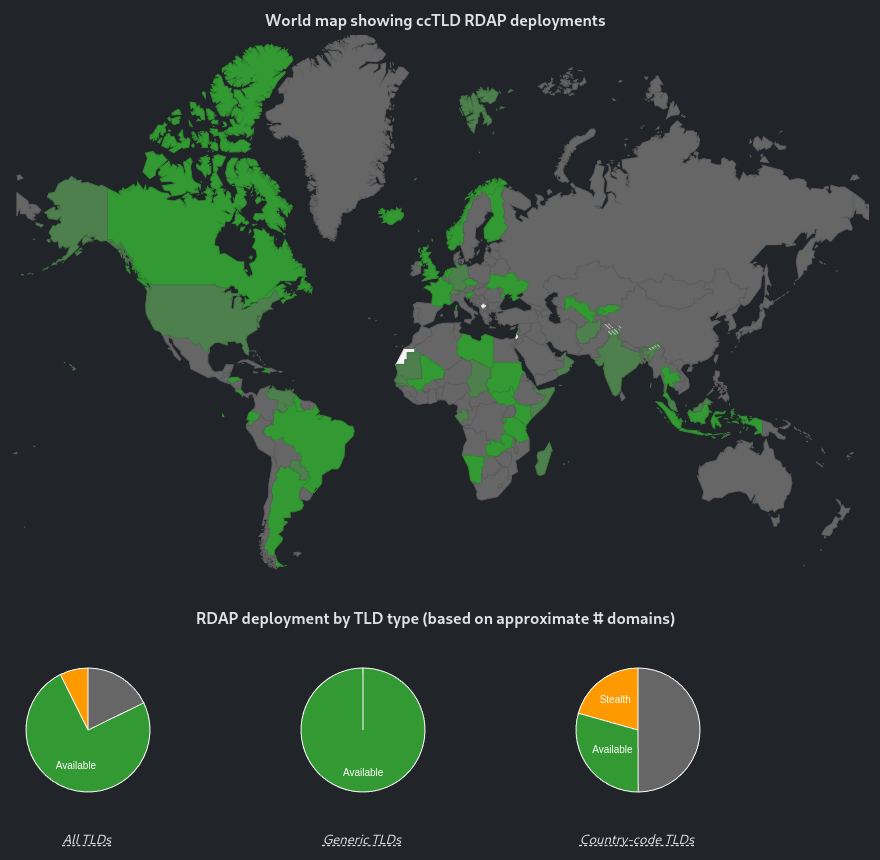History of RDAP
The Registration Data Access Protocol (RDAP) is the successor protocol to the Whois protocol. It was first ratified by the IETF in March 2015 by their WEIRDS working group, and initial server and client implementations were released by the American Registry for Internet Numbers (ARIN), the Latin American and Caribbean Internet Address Registry (LACNIC), and Asia Pacific Network Information Centre (APNIC) in June 2015. The following year the RIPE NCC deployed their service followed by AfriNIC.
Adoption by the DNRs was much slower. By 2018, only six registries had deployed RDAP services. However, in August 2019 ICANN stipulated that all registries and registrars were to deploy RDAP..
As of 2024, all 5 RIRs have deployed RDAP, all gTLDs have deployed RDAP, and 25% of ccTLDs have deployed RDAP according to the RDAP Deployment Dashboard.
 2025 RDAP deployment according to rdap.org
2025 RDAP deployment according to rdap.org
The Before Time
The Whois protocol has its origins in the very early days of computer networking and predates both DNS and the Internet. Before RDAP, there were many attempts at creating a successor protocol.
In 1994, Network Solutions published a specification for Referral Whois (RWhois) as Informational RFC 1714. Network Solutions was eventually purchased by VeriSign and then spun off into a domain registrar. RWhois is in limited use today by some Internet Service Providers in the ARIN region.
In 1995, the IETF published the Whois++ specification as a standards track protocol, RFC 1835. This protocol never found widespread deployment and is now considered Historic by the IETF.
In 1996, Sandia National Laboratory published an Informational RFC on using the X.500 Directory Access Protocol as a “white pages” service for the United States: RFC 1943.
And in December 2003, VeriSign published information on an experiment to use LDAP to replace Whois: RFC 3663. It was this experiment that led VeriSign to the conclusion that a protocol specifically designed for the problem space of Internet registries should be developed, and this led to the formation of the IETF’s Cross Registry Information Service Protocol (CRISP) working group.
The CRISP working group eventually produced the Internet Registry Information Service (IRIS) protocol, which used XML as its data serialization form and defined multiple application-layer transports which could be signaled using S-NAPTR DNS records. The original application transport was BEEP, but a simpler TCP-based protocol called XPC was also developed. IRIS also had a UDP-based transport called LWZ and defined a lightweight domain availability schema called DCHK.
Ultimately, VeriSign never deployed IRIS. However, IRIS DCHK was used by DeNIC and Afnic. The CRISP Requirements (RFC 3707) were used as an input to the WEIRDS working group which produced the RDAP specifications.
In 2010, ARIN developed Whois-RWS (where RWS stands for RESTful Web Service), which is an HTTP-based system for retrieving Whois information. With the experience of Whois-RWS and encouragement from ICANN staff to help pursue the SSAC 051 goals, the WEIRDS BoF was held in 2011 kicking off the WEIRDS working group, which then created the RDAP specifications.
%%{init: { 'logLevel': 'debug', 'theme': 'base' } }%%
timeline
title History of Whois and RDAP
section Pre-RDAP
1980s : 1982 - First Whois RFC (812) : 1985 - Second Whois RFC (954)
1990s : 1994 - RWhois : 1995 - Whois++ : 1996 - X.500 Whtie Pages
2000s : 2003 - Whois in LDAP : 2004 - Third Whois RFC (3912) : 2004 - CRISP Working Group Started : 2005 - First IRIS RFC
2010 : ARIN's Whois-RWS
section RDAP
2012 : WEIRDS Working Group Started
2015 : First RDAP RFCs